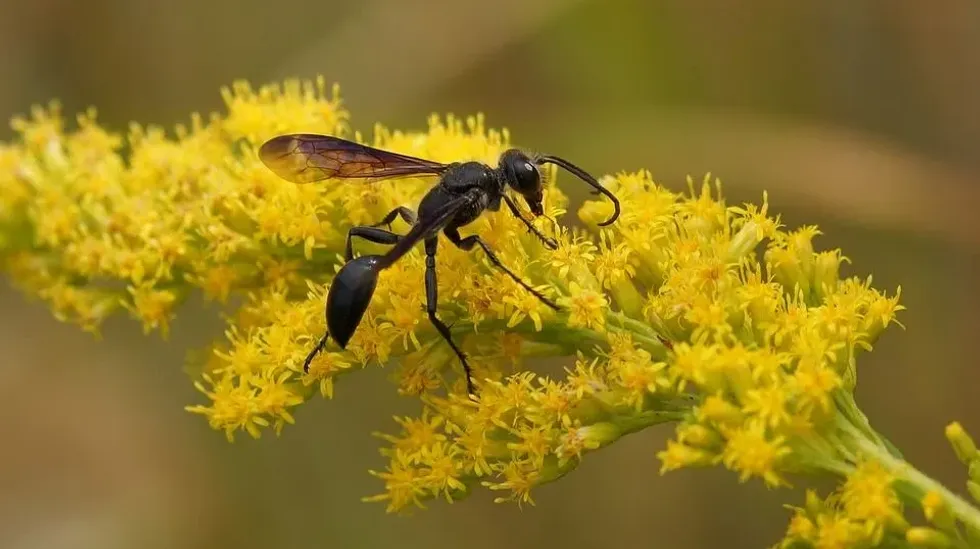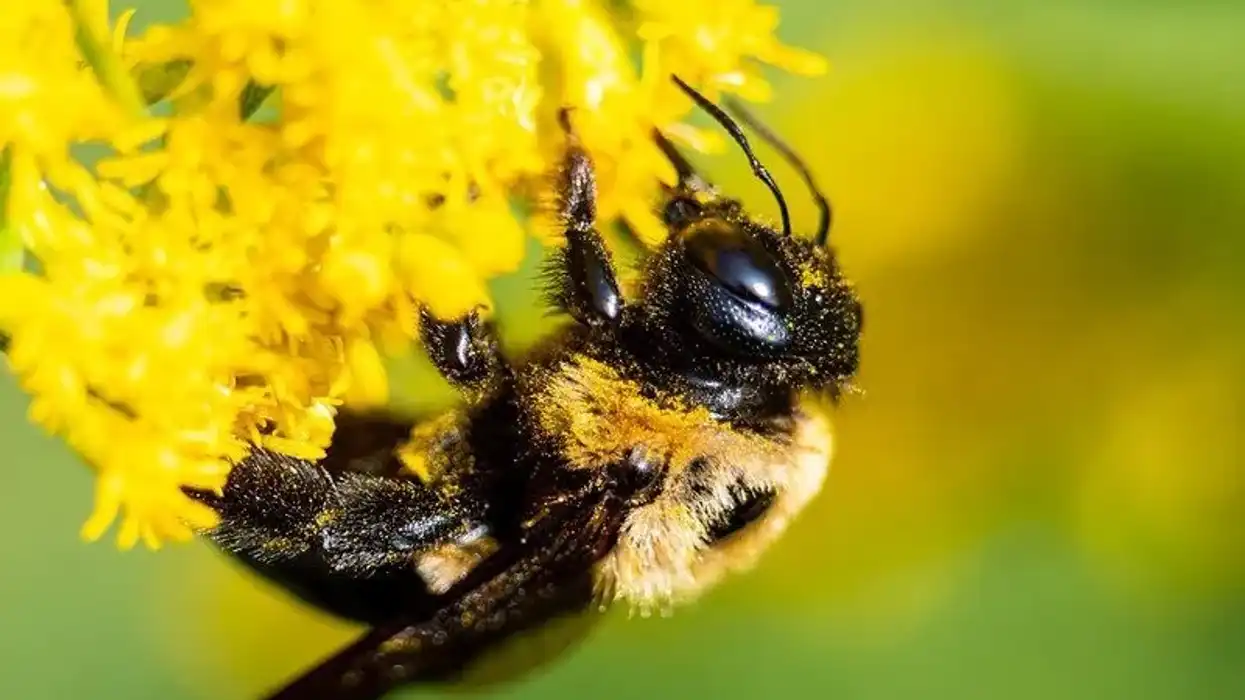The Great Black Wasp (Sphex pensylvanicus) is a large black wasp that belongs to the genus Sphex, which stings and paralyzes its prey. More than 130 Sphex species are known to science; these insects are also known as the digger wasp as they dig into the ground while nesting.
Wasps are generally divided into two types: social and solitary. Great black wasps are solitary wasps and prefer living alone, whereas others social wasps live in colonies of up to 10,000 individuals.
The Great Black Wasp is regarded as a pollinator and environmentally friendly. It is excellent for fields and gardens as it pollinates the flowers when it feeds itself and takes away the plant pests for feeding its young ones.
They aid in controlling Grasshoppers and Katydids, both of which eat plants and crops. Great Black Wasps are easily distinguished even when flying because they tend to drag their legs down.
At the same time, other types of wasps pull their legs up. When you find these wasps fly near gardens, they make a distinctive humming sound.
After learning about Great black wasp facts, you can also learn more about insects by reading our articles common wasp and honey bee.
Great Black Wasp Interesting Facts
What type of animal is a Great Black Wasp?
The Great Black is a wasp. Wasps are insects that are neither bees nor ants. Wasps do not form a clade, or a complete natural group with a single ancestor, as they share a common ancestor with bees and ants.
What class of animal does a Great Black Wasp belong to?
The Great Black Wasp is a member of the class Insecta of the order Hymenoptera and the Sphecidae Family, with the genus Sphex.
How many Great Black Wasps are there in the world?
The exact population of these insects is a bit difficult to know. However, with many Great Black Wasps, there is no risk that they will soon be extinct.
Where does a Great Black Wasp live?
They are mostly found all over North America, most of them in the contiguous United States and northern Mexico. Its range expanded northward into New York and the Canadian provinces of Quebec and Ontario in the late twentieth century.
What is a Great Black Wasp's habitat?
During July and September, Great Black wasp can be found visiting flowers in open areas like meadows and North America Fields. This digger wasp lives in an underground nest that they dig in soft soil.
Who do Great Black Wasps live with?
They are generally solitary wasps that do not form large colonies like other species, live alone all though their nests may contain multiple larvae and eggs.
How long does a Great Black Wasp live?
Like other similar species, a Black Wasp worker lives up to 12-22 days, while a Queen Wasp can survive up to a year.
How do they reproduce?
Male and female black wasps primarily mate in the spring. A fertile female wasp hibernates to the nest to lay eggs.
These female Black wasps will sting their prey like Katydids or Grasshoppers three times, then the prey is paralyzed, but it is still alive. The female wasp then drags it to the underground nest and lay their eggs directly on the prey insect stomach or beneath it. The egg eventually hatches and begins to eat that prey.
The prey is kept alive as long as possible while the larva feed and grow. Each chamber of the nest contains a single larva that consumes about two to six Katydids or Grasshoppers.
What is their conservation status?
Black wasps are the most common wasps in North America, and due to their steady population, their conservation status is Least Concern. However, researchers fear that these black wasps are misunderstood as serious pests due to a lack of knowledge on the significant role of wasps in the ecosystem.
These Black wasps are good pollinators and regulate populations of crop pests and insects that carry human diseases. Increased pest control in managed landscapes and habitat loss may cause in decline in the population of these wasps in the future.
Great Black Wasp Fun Facts
What do Great Black Wasps look like?
As the name goes, the great black Wasp has an entirely black body without any stripes or other markings, unlike most other wasps. They have a standard wasp body with darker and smoky wings, a large head and eyes, a very tiny thin waist, and a large back.
How cute are they?
A friendly Great Black wasp in your garden has a blue iridescence on its smoky black wings - kind of cute to watch. These digger wasps are generally found in summer; eating nectar and pollen from flowers lures this site by nature-lovers.
How do they communicate?
Black Wasps communicate with their sense of smell. These wasps emit chemicals called pheromones through which they communicate danger, attract a mate, and signal where food is available.
How big is a Great Black Wasp?
A male Great Black Wasp size ranges from 0.7-1.1 in (19-28 mm) in length, and females range from 1-1.3 in (25-34 mm). It is larger than the Great Golden Digger Wasp.
How fast can Great Black Wasps move?
Most wasps can travel hundreds of miles in few hours. A Black wasp, like similar species, can fly at speeds ranging from 7-30 mph.
How much does a Great Black Wasp weigh?
A study found that a wasp's weight ranged from 29.7-159 mg. Being the largest of all wasps, the black Wasp may be on the higher end of the scale.
What are their male and female names of the species?
A male Black Wasp is called a drone, and a fertile female Black wasp generally becomes a queen.
What would you call a baby Great Black Wasp?
They develop from eggs to larvae, later termed juvenile wasp until it turns into the adult wasp.
What do they eat?
Black wasps prey on Grasshoppers, Katydids, locusts, and cicadas right from the larvae stage. Once they become adults, they consume nectar and pollen from the garden's flowers.
Are they harmful?
The Great Black Wasp is not a dangerous insect. Being stung by a black wasp is extremely rare due to its solitary nature. However, if they are scared, they may sting you, and only females in black wasps sting. This wasp's sting is painful, but it does not swell like other wasp stings.
Would they make a good pet?
These insects can be kept as pets in commercial farms because they naturally reduce pests' population and boost agricultural productivity.
Did you know...
Even though they aren't particularly dangerous, if you have an overabundance of black wasps in your garden, you'll need to use these tricks to deal with them. Initially, limit the food sources.
Spray a permethrin-based pesticide on the nests of black wasps to destroy the wasps inside and any egg. Spray WD-40 Multi-Purpose Lubricant Aerosol Spray directly into a nest or onto a wasp for quick grounding and killing but avoid breathing it in, which can be harmful.
Since wasps cannot nest effectively in rocky soil, adding gravel or other small stones to the top layer of soil will prevent them from establishing nests. You need to hire a professional in case you find significantly more numbers.
Attracting Great Black Wasps
Black wasps get attracted to the blooming flowers and nectar, so keeping such plants in your yard is like inviting them in. If there isn't enough food around your house, these wasps will look for another place to nest.
The Great Black Wasp's sting
If a person handles or threatens a Great Black Wasp, they may receive a painful sting. Although the stings are painful, it is not considered fatal, except that a Great Black Wasp stung may be as dangerous if you are allergic.
With Great Black Wasp sting, you might experience skin hives, pain, swelling, warmth, and skin redness. Here's how to take care of a wasp sting at home.
Wash the affected area with water and mild soap, then apply an ice cube to reduce the pain and swelling. If possible, raise the body part where the sting occurred to reduce swelling.
Use a pain killer in case of itching or swelling. If the medicine is not readily available, you can apply a baking powder paste or a wet tea bag.
Visit a doctor immediately if you experience symptoms of an allergic reaction including trouble breathing, tightness or a tickling in the throat or chest, or feeling dizzy.
Here at Kidadl, we have carefully created lots of interesting family-friendly animal facts for everyone to discover! Learn more about some other arthropods, including crab spider or atlas beetle.
You can even occupy yourself at home by drawing one on our great black wasp coloring pages.










